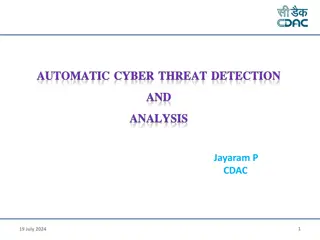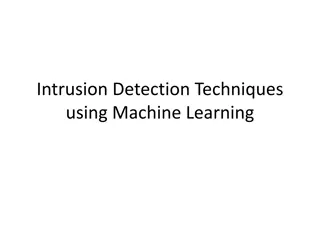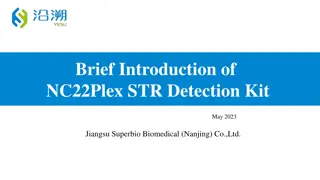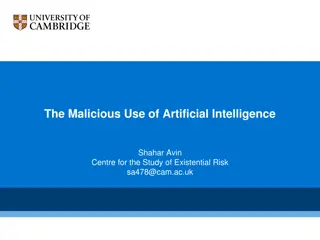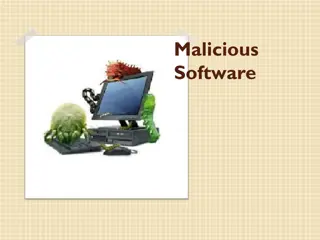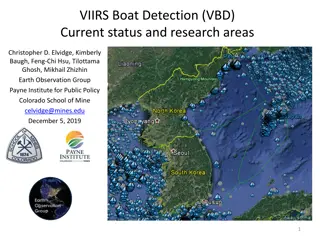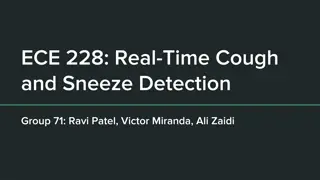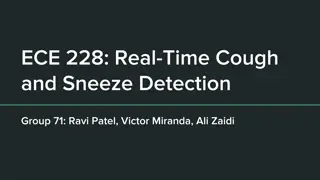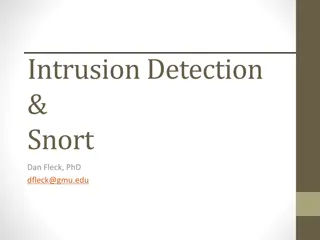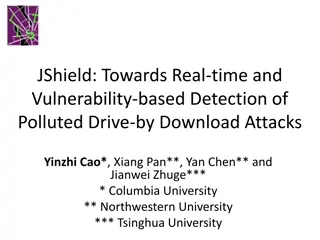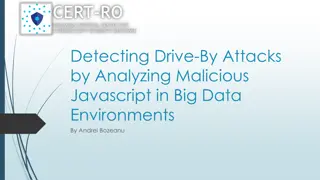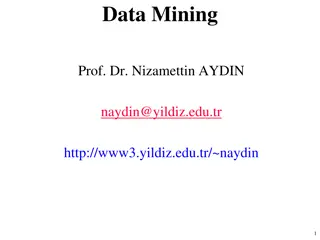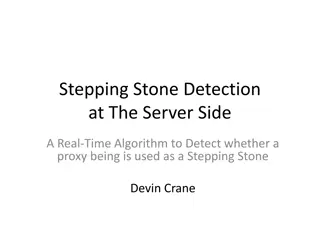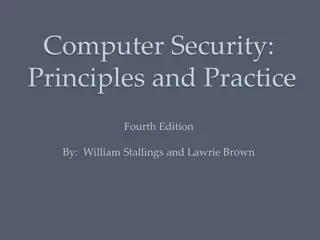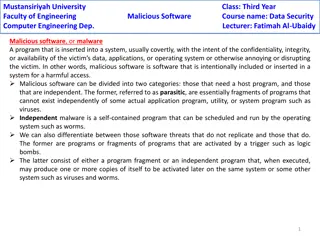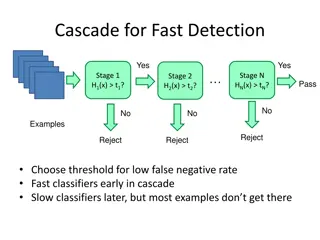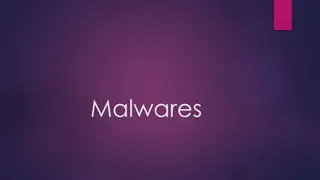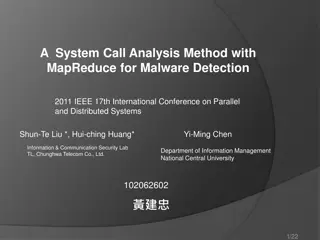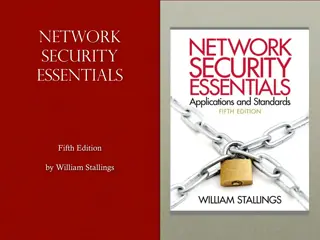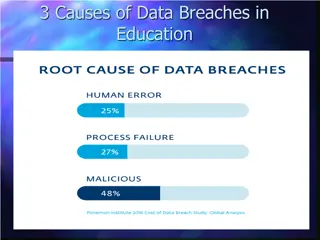Understanding Malicious Attacks, Threats, and Vulnerabilities in IT Security
Malicious attacks, threats, and vulnerabilities in IT systems pose significant risks and damages. This chapter explores the types of attacks, tools used, security breaches, and measures to protect against cyber threats. Learn how security professionals safeguard organizations from malicious attacks
0 views • 24 slides
Understanding Typosquatting in Language-Based Package Ecosystems
Typosquatting in language-based package ecosystems refers to the malicious practice of registering domain names that are similar to popular packages or libraries with the intention of tricking developers into downloading malware or compromised software. This threat vector is a serious issue as it ca
0 views • 23 slides
Automated Anomaly Detection Tool for Network Performance Optimization
Anomaly Detection Tool (ADT) aims to automate the detection of network degradation in a mobile communications network, reducing the time and effort required significantly. By utilizing statistical and machine learning models, ADT can generate anomaly reports efficiently across a large circle network
8 views • 7 slides
Drone Detection Using mmWave Radar for Effective Surveillance
Utilizing mmWave radar technology for drone detection offers solutions to concerns such as surveillance, drug smuggling, hostile intent, and invasion of privacy. The compact and cost-effective mmWave radar systems enable efficient detection and classification of drones, including those with minimal
0 views • 8 slides
Cyber Threat Detection and Network Security Strategies
Threat detection is crucial in analyzing security ecosystems to identify and neutralize malicious activities. Methods like leveraging threat intelligence, behavior analytics, setting intruder traps, and conducting threat hunts are essential for proactive security. Implementing security through obscu
1 views • 51 slides
Machine Learning Techniques for Intrusion Detection Systems
An Intrusion Detection System (IDS) is crucial for defending computer systems against attacks, with machine learning playing a key role in anomaly and misuse detection approaches. The 1998/1999 DARPA Intrusion Set and Anomaly Detection Systems are explored, alongside popular machine learning classif
0 views • 36 slides
Efficient Malicious URL Detection with Bloom Filters
Google's Chrome team faces the challenge of detecting malicious URLs without heavy memory usage. Universal hashing and Bloom Filters are discussed as innovative solutions to address this issue efficiently and effectively, illustrating how K-independent hash functions can improve detection accuracy w
0 views • 19 slides
NC22Plex STR Detection Kit: Advanced 5-Color Fluorescence Detection System
Explore the cutting-edge NC22Plex STR Detection Kit from Jiangsu Superbio Biomedical, offering a 5-color fluorescence detection system suitable for multiple applications. Enhance your research capabilities with this innovative product designed for precision and efficiency.
0 views • 20 slides
Automated Melanoma Detection Using Convolutional Neural Network
Melanoma, a type of skin cancer, can be life-threatening if not diagnosed early. This study presented at the IEEE EMBC conference focuses on using a convolutional neural network for automated detection of melanoma lesions in clinical images. The importance of early detection is highlighted, as exper
0 views • 34 slides
Exploring the Malicious Use of Artificial Intelligence and its Security Risks
Delve into the realm of artificial intelligence and uncover the potential risks associated with its malicious applications, including AI safety concerns and security vulnerabilities. Discover common threat factors and security domains that play a vital role in combating these challenges.
0 views • 30 slides
Colorimetric Detection of Hydrogen Peroxide Using Magnetic Rod-Based Metal-Organic Framework Composites
Nanomaterials, particularly magnetic rod-based metal-organic frameworks composites, are gaining attention for their exceptional properties and various applications in different fields. This study by Benjamin Edem Meteku focuses on using these composites for colorimetric detection of hydrogen peroxid
0 views • 16 slides
Understanding Typosquatting in Language-Based Package Ecosystems
Typosquatting in language-based package ecosystems involves malicious actors registering similar-sounding domain names to legitimate ones to deceive users into downloading malware or visiting malicious sites. This practice poses a significant threat as users may unknowingly install compromised packa
0 views • 23 slides
Understanding Malicious Software and Its Impact on Computer Systems
Malicious software, commonly known as malware, poses a serious threat to computer systems by exploiting vulnerabilities. This content covers various terminologies, categories, and types of malware, including viruses, worms, rootkits, spyware, and adware. It also delves into how malware can cause dam
0 views • 16 slides
VIIRS Boat Detection (VBD) Research Overview
The Visible Infrared Imaging Radiometer Suite (VIIRS) program, a joint effort between NASA and NOAA, focuses on weather prediction and boat detection using low light imaging data collected at night. The VIIRS system provides global coverage with sensitive instruments and efficient data flow processe
1 views • 13 slides
Real-Time Cough and Sneeze Detection Project Overview
This project focuses on real-time cough and sneeze detection for assessing disease likelihood and individual well-being. Deep learning, particularly CNN and CRNN models, is utilized for efficient detection and classification. The team conducted a literature survey on keyword spotting techniques and
1 views • 15 slides
Stop Hidden Water Damage: Your Ultimate Guide to Leak Detection in San Diego
Learn how San Diego leak detection services can help protect your home from water damage. Discover the signs of leaks, advanced detection technologies, and tips to prevent costly repairs. Stay ahead with proactive slab leak detection and expert solut
0 views • 6 slides
GOES-R ABI Aerosol Detection Product Validation Summary
The GOES-R ABI Aerosol Detection Product (ADP) Validation was conducted by Shobha Kondragunta and Pubu Ciren at the NOAA/NESDIS/STAR workshop in January 2014. The validation process involved testing and validating the ADP product using proxy data at various resolutions for detecting smoke, dust, and
1 views • 21 slides
Real-Time Cough and Sneeze Detection Using Deep Learning Models
Detection of coughs and sneezes plays a crucial role in assessing an individual's health condition. This project by Group 71 focuses on real-time detection using deep learning techniques to analyze audio data from various datasets. The use of deep learning models like CNN and CRNN showcases improved
0 views • 15 slides
Development of Satellite Passive Microwave Snowfall Detection Algorithm
This study focuses on the development of a satellite passive microwave snowfall detection algorithm, highlighting the challenges in accurately determining snowfall using satellite instruments. The algorithm uses data from AMSU/MHS, ATMS, and SSMIS sensors to generate snowfall rate estimates, overcom
0 views • 20 slides
Overview of GRANDproto Project Workshop on Autonomous Radio Detection
GRANDproto project workshop held in May 2017 focused on improving autonomous radio detection efficiency for the detection of extensive air showers (EAS). Issues such as detector stability and background rates were discussed, with the goal of establishing radio detection as a reliable method for EAS
1 views • 14 slides
Timely Leak Detection San Diego | Professional Leak Detection Services
Protect your home with expert leak detection services in San Diego. Avoid costly water damage and health risks with timely detection of hidden leaks. Schedule today!\n\nKnow more: \/\/ \/san-diego-slab-leak-detection\/
0 views • 7 slides
How Professional Leak Detection Can Save Your San Diego Home | Leak Detection Sa
Protect your home from costly damage with professional leak detection in San Diego. Learn about expert services like slab leak detection, non-invasive testing, and more. Save money and prevent water damage with top San Diego leak detection services.\
0 views • 8 slides
Understanding Snort: A Comprehensive Overview
Snort is an open-source network intrusion detection system (NIDS) widely utilized in the industry. It employs a rule-based language combining various inspection methods to detect malicious activities like denial of service attacks and port scans. The components, architecture, and detection engine of
0 views • 25 slides
Understanding Intrusion Detection Systems (IDS) and Snort in Network Security
Intrusion Detection Systems (IDS) play a crucial role in network security by analyzing traffic patterns and detecting anomalous behavior to send alerts. This summary covers the basics of IDS, differences between IDS and IPS, types of IDS (host-based and network-based), and the capabilities of Snort,
0 views • 34 slides
Real-Time Detection of Polluted Drive-by Download Attacks with JShield
Protecting against drive-by download attacks, JShield offers a real-time, vulnerability-based detection system that identifies malicious JavaScript samples. With a focus on mitigating sample pollution and evasive tactics, this innovative approach has been implemented by a leading telecommunications
0 views • 24 slides
Detecting Drive-By Attacks: Analysis of Malicious Javascript in Big Data Environments
Cybersecurity researcher Andrei Bozeanu delves into the complex world of polymorphic viruses, heuristic analysis, and the similarities between polymorphic viruses and malicious Javascript. Discover how these threats operate and evade detection, highlighting the importance of understanding malware be
0 views • 48 slides
Understanding Malware: Types, Symptoms, and Countermeasures
Malware is malicious software that can alter computer settings, behavior, files, services, ports, and speed. Sources of malware include insufficient security, honeypot websites, free downloads, torrents, pop-ups, emails, and infected media. Symptoms of malware include unusual computer behavior, slow
0 views • 9 slides
Advances in Authenticated Garbling for Secure 2PC
The research discusses advancements in authenticated garbling for achieving constant-round malicious secure 2PC using garbled circuits. It emphasizes the utilization of correlated randomness setup and efficient LPN-style assumptions to enhance communication efficiency significantly. Various techniqu
0 views • 30 slides
Understanding Anomaly Detection in Data Mining
Anomaly detection is a crucial aspect of data mining, involving the identification of data points significantly different from the rest. This process is essential in various fields, as anomalies can indicate important insights or errors in the data. The content covers the characteristics of anomaly
0 views • 50 slides
Stepping Stone Detection at the Server Side: Real-Time Algorithm
An innovative real-time algorithm is introduced to detect the use of a proxy as a stepping stone from the server's perspective. The solution addresses the limitations of existing methods by focusing on TCP connection initiation. Previous research and vulnerabilities related to proxy servers and step
0 views • 37 slides
Understanding Malicious Software in Computer Security
In "Computer Security: Principles and Practice," the chapter on Malicious Software covers various types of malware such as viruses, adware, worms, and rootkits. It defines malware, Trojan horses, and other related terms like backdoors, keyloggers, and spyware. The chapter also discusses advanced thr
0 views • 49 slides
Understanding Malicious Software in Data Security
Malicious software, or malware, poses a threat to the confidentiality, integrity, and availability of data within systems. It can be parasitic or independent, with examples like viruses, worms, Trojan horses, and e-mail viruses. Understanding the different types of malware and their modes of operati
0 views • 5 slides
Buffer Overflow Attack and Vulnerable Programs
Understanding buffer overflow attacks and vulnerable programs, the consequences of such attacks, how to run malicious code, and the setup required for exploiting vulnerabilities in program memory stack layouts. Learn about creating malicious inputs (bad files), finding offsets, and addressing shellc
0 views • 36 slides
Exploring Java Sandbox Flexibility and Usage
The research delves into evaluating the flexibility and practical usage of the Java sandbox in dealing with Java applications. It highlights the importance of investigating how security tools are utilized, aiming to enhance security mechanisms and differentiate between malicious and benign code. The
0 views • 28 slides
Object Detection Techniques Overview
Object detection techniques employ cascades, Haar-like features, integral images, feature selection with Adaboost, and statistical modeling for efficient and accurate detection. The Viola-Jones algorithm, Dalal-Triggs method, deformable models, and deep learning approaches are prominent in this fiel
0 views • 21 slides
Understanding Malware: Types, Risks, and Prevention
Malware, short for malicious software, is designed to disrupt, damage, or gain unauthorized access to computer systems. Malware includes viruses, worms, trojans, ransomware, adware, spyware, rootkits, keyloggers, and more. They can be spread through various means like malicious links, untrusted down
0 views • 15 slides
MapReduce Method for Malware Detection in Parallel Systems
This paper presents a system call analysis method using MapReduce for malware detection at the IEEE 17th International Conference on Parallel and Distributed Systems. It discusses detecting malware behavior, evaluation techniques, categories of malware, and approaches like signature-based and behavi
0 views • 22 slides
Understanding Malicious Software: Classification and Payload Actions
Malicious software, or malware, can be broadly classified based on how it spreads and the actions it performs once on a target system. This classification includes distinctions between viruses, worms, trojans, botnets, and blended attacks. The payload actions of malware can range from file corruptio
0 views • 44 slides
Overview of Static Bug Detection in Software Quality Assurance
Static bug detection is a less popular but effective approach for software quality assurance compared to traditional testing methods. It involves tools like Findbugs that help identify potential issues in code before deployment, such as bad coding styles, null pointer dereferences, and malicious cod
0 views • 36 slides
Understanding Data Breach Causes in Education
Data breaches in education are often caused by human errors, process failures, and malicious breaches. Human errors include leaving computers unlocked, sharing passwords, and carelessly discarding sensitive information. Process failures involve not keeping software up-to-date, lack of security polic
0 views • 15 slides




